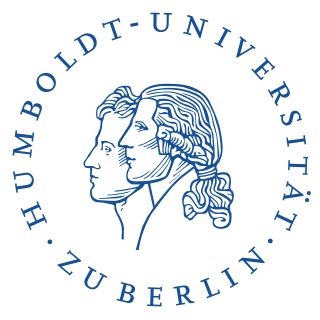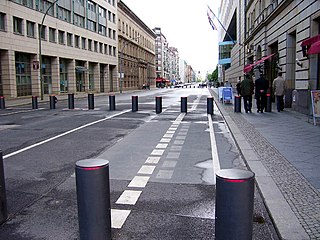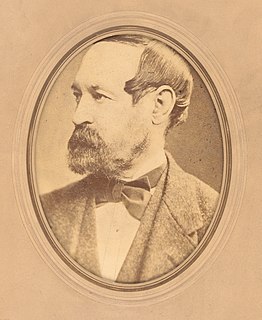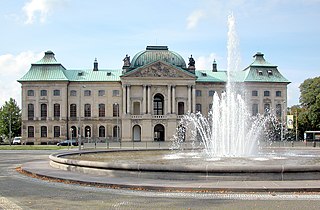
Unter den Linden is a boulevard in the central Mitte district of Berlin, the capital of Germany. Running from the City Palace to Brandenburg Gate, it is named after the linden (lime) trees that line the grassed pedestrian mall on the median and the two broad carriageways. The avenue links numerous Berlin sights, landmarks and rivers for sightseeing.

Humboldt University of Berlin is a German public research university in the central borough of Mitte in Berlin. It was established by Frederick William III on the initiative of Wilhelm von Humboldt, Johann Gottlieb Fichte and Friedrich Ernst Daniel Schleiermacher as the University of Berlin in 1809, and opened in 1810, making it the oldest of Berlin's four universities. From 1828 until its closure in 1945, it was named Friedrich Wilhelm University. During the Cold War the university found itself in East Berlin and was de facto split in two when the Free University of Berlin opened in West Berlin. The university received its current name in honour of Alexander and Wilhelm von Humboldt in 1949.

The German Chancellery is an agency serving the executive office of the chancellor of Germany, the head of the federal government, currently Olaf Scholz. The Chancellery's primary function is to assist the chancellor in coordinating the activities of the federal government. The Head of the Chancellery holds the rank of either a Secretary of State (Staatssekretär) or a Federal Minister (Bundesminister), currently held by Wolfgang Schmidt. The headquarters of the German Chancellery is at the Federal Chancellery building in Berlin, which is the largest government headquarters in the world.

Wilhelmstrasse is a major thoroughfare in the central Mitte and Kreuzberg districts of Berlin, Germany. Until 1945, it was recognised as the centre of the government, first of the Kingdom of Prussia, later of the unified German Reich, housing in particular the Reich Chancellery and the Foreign Office. The street's name was thus also frequently used as a metonym for overall German governmental administration: much as the term "Whitehall" is often used to signify the British governmental administration as a whole. In English, "the Wilhelmstrasse" usually referred to the German Foreign Office.

The Neue Wache is a listed building on Unter den Linden boulevard in the historic centre of Berlin, Germany. Erected from 1816 to 1818 according to plans by Karl Friedrich Schinkel as a guardhouse for the Royal Palace and a memorial to the Liberation Wars, it is considered a major work of Prussian Neoclassical architecture. A Victoria pedimental sculpture by Johann Gottfried Schadow and five General statues by Christian Daniel Rauch, referring to the Warrior statues on Schlossbrücke, also belong to the ensemble. Since 1993, the Neue Wache has been home to the Central Memorial of the Federal Republic of Germany to the Victims of War and Tyranny.

The New Palace is a palace situated on the western side of the Sanssouci park in Potsdam, Germany. The building was begun in 1763, after the end of the Seven Years' War, under King Friedrich II and was completed in 1769. It is considered to be the last great Prussian Baroque palace.

Carl Gotthard Langhans was a Prussian master builder and royal architect. His churches, palaces, grand houses, interiors, city gates and theatres in Silesia, Berlin, Potsdam and elsewhere belong to the earliest examples of Neoclassical architecture in Germany. His best-known work is the Brandenburg Gate in Berlin, national symbol of today’s Germany and German reunification in 1989/90.

Georg Friedrich Heinrich Hitzig was a German architect, born into the Jewish Itzig family, converted to Lutheranism. He was a student of Karl Friedrich Schinkel.

The Palais Strousberg was a large city mansion built in Berlin, Germany for the railway magnate Bethel Henry Strousberg. It was designed by the architect August Orth and built between 1867–68 at No.70 Wilhelmstraße. The grandiose splendour of its accommodation and novel integration of the latest building technologies into the fabric of the building, ensured that Berliners would still find the Palais impressive decades after its construction, becoming the model of refined luxury in Berlin architecture.

The Prussian House of Lords in Berlin was the upper house of the Landtag of Prussia, the parliament of Prussia from 1850 to 1918. Together with the lower house, the House of Representatives (Abgeordnetenhaus), it formed the Prussian bicameral legislature. The building is now used as the seat of the German Bundesrat.

The Japanisches Palais is a Baroque building in Dresden, Saxony, Germany. It is locate on the Neustadt bank of the river Elbe.

The Maxim Gorki Theatre is a theatre in Berlin-Mitte named after the Soviet writer, Maxim Gorky. In 2012, the Mayor of Berlin Klaus Wowereit named Şermin Langhoff as the artist director of the theatre.

The Prinz-Albrecht-Palais was a Rococo city palace in the historic Friedrichstadt suburb of Berlin, Germany. It was located on Wilhelmstrasse 102 in the present-day Kreuzberg district, in the vicinity of Potsdamer Platz.

The Borsig Palace was an iconic building at the corner of Voßstraße and Wilhelmstraße in the center of Berlin and one of the grandest Italianate villas in Germany. Completed in 1877 for industrialist Albert Borsig, who died before he could move in, the building served for a time as a bank. In 1933 it became the residence of Vice-Chancellor Franz von Papen, where dramatic scenes relating to the Night of the Long Knives would play out just one year later. In the aftermath, Palais Borsig was converted into the new headquarters of the Sturmabteilung on Adolf Hitler's direct orders. It was then integrated into the New Reich Chancellery by Albert Speer in 1938. The palace was severely damaged in World War II and, together with Hitler's Chancellery, demolished by the Soviet forces in 1947.

The Kronprinzenpalais is a former Royal Prussian residence on Unter den Linden boulevard in the historic centre of Berlin. It was built in 1663 and renovated in 1857 according to plans by Heinrich Strack in Neoclassical style. From 1919 to 1937, it was home to the modern art collection of the National Gallery. Damaged during the Allied bombing in World War II, the Kronprinzenpalais was rebuilt from 1968 to 1970 by Richard Paulick as part of the Forum Fridericianum. In 1990, the German Reunification Treaty was signed in the listed building. Since then, it has been used for events and exhibitions.

The Palais am Festungsgraben, originally known as the Palais Donner, is a stately building in Berlin’s Mitte subdistrict located behind, and facing, the ensemble of chestnut trees around the Neue Wache, near the eastern terminus of the boulevard Unter den Linden. The name refers to its construction next to a redundant canal, gradually filled in by 1883, which had originally been a moat surrounding the 17th century city wall. Built as a private residence, it later housed a succession of Prussian government offices, and after World War II various cultural institutions in the Soviet sector of Berlin. After administrative authority was transferred to the newly established German Democratic Republic (GDR) in 1949 it hosted a succession of institutions established to further German-Russian contacts. Since German reunification it has accommodated a theater and from 2004 an art gallery.

The Russian Embassy in Germany is the headquarters of the diplomatic mission of the Russian Federation in Germany. It is located in the Mitte district of the capital Berlin and occupies a building complex consisting of the main building at 63-65 Unter den Linden and several administrative and residential buildings on the Behrenstraße and Glinkastraße.

The Old Palace, also called Kaiser Wilhelm Palace (Kaiser-Wilhelm-Palais), is a former Royal Prussian residence on Unter den Linden boulevard in Mitte, the historic heart and city center of Berlin. It was built between 1834 to 1837 by order of Prince William of Prussia, who later became German Emperor William I, according to plans by Carl Ferdinand Langhans in Neoclassical style. Damaged during the Allied bombing in World War II, the Old Palace was rebuilt from 1963 to 1964 as part of the Forum Fridericianum. Since then, the listed building has been home to the Law Faculty of the Humboldt-Universität.

The Ephraim Palace is a Rococo-style building in Berlin, Germany, originally constructed in 1766. Despite the destruction of the palace in 1936 by Nazi Germany, the beginning of a reconstruction was possible in 1985, as many elements of the facade had been stored in East Germany. Today, the Ephraim Palace is a cultural-heritage property and houses a museum, mostly dealing with cultural topics.




















